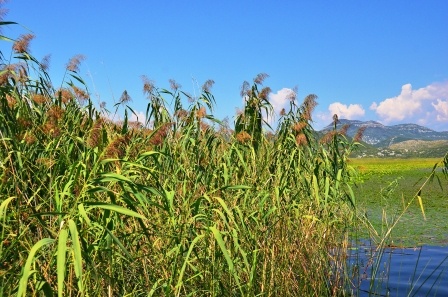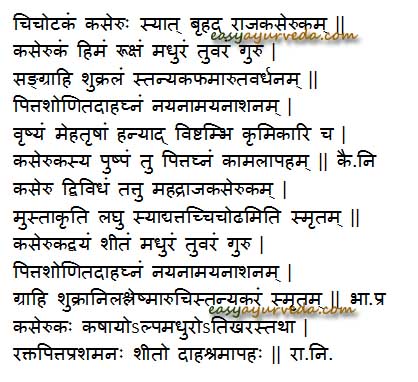Kaseru (Scirpus grossus) Uses, Research, Medicines, Side Effects
Kasheruka – Scirpus grossus is an Ayurvedic herb used for the treatment for diarrhea, thirst, nausea, scanty micturition, jaundice, improving the sperm count and weakness of the cardiac muscles.
This plant is widely used by traditional practitioners for the treatment of eye diseases, applied over burns, pills, information etc. It is also used internally to cure vomiting, diarrhoea, cholera, Jaundice, seminal debility, fever, and urinary bladder. Above all it is one of the best cardiotonic.

Latin name – Scirpus grossus Linn.
Family – Cyperaceae (Mustaka kula)
Table of Contents
Vernacular names
Names in different languages:
Hindi name – Kaseru
English name – club – rush or bulrush, Deer Grass, Grass Weed
Assamese name – Kaheru
Bengali name – Keshura, Kashura
Gujarati name – Kasela, Gundaro
Kannada name – Kasura gadde
Malayalam name – kazhi muttanga
Marathi name – kachera, Kasara
Oriya name – Kaseru kawdu
Tamil name – Gundtiga gaddi
Telugu name – Gundatunga gatti
Urdu and Punjabi name – Kaseru
Sanskrit synonyms
Sanskrit Synonyms of Kaseru:
Kaseru, Kaseruka – The plant needs plenty of water to grow – Kasheyath val kash shabde. Kaseru sadrasha thrna visesha. It resembles Scirpus kysoor.
Sugandhi, Gandhakanda – The tuber has pleasant smell
Shukareshta – liked by pigs
Gudakanda, Gundakanda, Jaluka, Shudramusta, Swalpakanda
Chichotaka, Kshudra Musta
Morphology
Morphology of Scirpus grossus:
This is a medium sized plant growing near the water source, having a 3 – 6 feet height growing stem with triangular shape. They have grass – like leaves, growing to a length of 2 – 3 inch and 1 inch wide and clusters of small spikelets, often brown. The fruits are small brownish colored. The rhizomes are blackish colored outside, having hair-like structure. Inside the rhizome, it is white colored, sweet in taste and has a pleasant odor. The flowers and fruits are seen in the month of September to October. The plant is found all over India near water sources like rivers, lakes and swampy areas.
Properties, part used, dosage
Properties of Deer Grass, Grass Weed:
Rasa (Taste) – Madhura (Sweet), Kashaya (Astringent)
Guna (Qualities) – Guru (Heavy), Ruksha (Dry)
Vipaka – Madhura (Undergoes sweet taste after digestion)
Veerya (Potency) – Sheeta (Cold)
Karma (Actions) – Pitta shamaka (reduces pitta dosha) and kapha vardhaka (increase kapha dosha)
Part used – Rhizome
Dosage – Powder – 5 to 10 g
Lepa – external application – 5 to 10 g
Kwatha – decoction – 10 to 20 ml
Rhizome: 1.5 to
Properties as per Bhojana Kutuhalam
Kaseruka helps in treating amlapitta, anorexia, vomiting, burning sensation, delusion, thirst, intoxication, felling tired without any physical work. It is very cold in potency, relieves dryness of throat, heavy and wholesome in vatarakta and chest injury.
Chemical composition
Chemical composition of Scirpus grossus:
The tuber gave progesterone, sugars, tannins, starch and saponins. The fruit contains amylase.
Uses of Kasheruka
- To treat burning sensation in the eyes, in conditions of conjunctivitis, the cold infusion prepared from the rhizome of Kasheruka is used as eye drops.
- In conditions of burning sensation all over the body due to fever, thirst and skin eruptions in summer season, the cold infusion of the rhizome of Scirpus grossus is given in a dose of 40 – 50 ml.
- The powder of the rhizome is mixed with ghee and applied over the skin in conditions of herpes, wound and boils.
- In conditions of nausea and diarrhea, the powder of the rhizome of Scirpus grossus is given in a dose of 5 – 10 g with hot water.
- In conditions of acute diarrhea, the powder of the rhizome is given with rose water.
- To improve the sperm count, the powder of Scirpus grossus is given in a dose of 3 – 5 g mixing with milk.
- To improve the strength of the cardiac muscles the cold infusion of Kasheruka is given with bark of Arjuna powder (Terminalia arjuna).
- The flowers of Scirpus grossus are made into paste and given in condition of jaundice as part of treatment.
- To improve the quantity of breast milk in lactating women, the cold infusion of the rhizome is given in a dose of 40 – 50 ml.
- In conditions of burning urination and scanty urinatin, the cold infusion of the rhizome of Scirpus grossus is given in a dose of 30 – 40 ml.
Sanskrit verse

Traditional description, Indications
Therapeutic uses
Netra roga- Cold infusion of Kaseruka and madhuka is used as eye drop (ss.ut. 12)
Garbha pata- Paste of Kaseruka, srmgataka and lotus tuber shall be given with boiled milk (SS.Sa.10)
Cholera-rhizome of Kaseruka rubbed with rose water.
Chardi- paste of root and tubers of Kaseruka with milk.
Traditional description of Kaseru:
Sheeta – coolant
Madhura – sweet
Tuvara – astringent
Guru – heavy to digest
Grahi – absorbent, useful in diarrhea, IBS
Shukrakara – increases semen and sperm
Stanyakara – promotes lactation
Indicated in
Raktapitta –Bleeding disorders such as nasal bleeding, heavy periods, etc
Daha – burning sensation, as in gastritis, neuropathy, burning sensation in eyes etc
Nayanamaya – eye disorders
Shrama – tiredness, fatigue
Adverse effect
There is no known or reported adverse effect of Kasheruka.
Ayurvedic medicines
Ayurvedic medicines containing Kasheruka:
Veeratharadi gana kashaya choorna: It is a powder made into decoction which is indicated in the diseases caused by vitiation of vata, acts as a diuretic, recommended in dysuria, retention of urine, renal calculi, renal colic etc.
Gandha taila: It is an oil which is used in the treatment of arthritis, osteoporosis, Fracture, dislocation.
It helps to improve strength of bones, joints and ligaments.
Vastyamayantaka ghrita: It is a medicated ghee used for preparatory procedure for Panchakarma and also as medicine, used in the treatment of diseases related to urinary system.
Panchajeeraka gudam: It is a medicine for post natal care, useful in digestive, cough, cold, rhinitis, bronchitis and asthma.
Shatavaryadi ghrita: It is a medicated ghee useful in treating urinary tract diseases, difficulty in urination, gonorrhoea and calculi, in burning in stomach and ache in the limbs.
Classical categorization
Classical categorization of Kasheru:
Bhavaprakasha – Shaka varga
Kaiyyadeva Nighantu – Oushadhi varga
Raja Nighantu – Shalmalyadi varga
Scientific classification
Scientific classification of Bulrush:
Kingdom: Plantae
Order: Poales
Family: Cyperaceae
Genus: Scirpus
Species: Grossus
Text references
There is no mention of this drug in Vedas and Puranas. This drug is widely explained in Brahat trayi’s and by Bhava Prakasha. According to Thakurji, S. kysoor and S. grossus are one and the same.
In Astanga Hridaya, the gunas of kaseruka are mentioned.
In Brahat trayi’s Charaka mentioned about this drug in sutra stana, vimana stana, sidhi stana.
In Susrutha Samhita he mentioned sutra stana, chikistha stana, sarira sthana and uttara sthana.
There is no reference in Astanga Sangraha by Vagbbatta.
But there is reference in Astanga Hridaya in sutra stana, sarira stana. chikista stana.
There is reference about this drug in Adarsha Nighantu, Raja Nighantu, Kaideva Nighantu. But no reference in Dhanvantari Nighantu, Shaligrama, Madhanapala nighantu etc.
Distribution and habitat
Found in swampy places or at the margins of ponds, in India and China.
Controversy: Kaseruka according to Raja Nighantu is Kshudramusta, a small variety of musta.
Author: Dr.B.K.Prashanth M.D (Ayu), Ph.D
E mail: [email protected]
Click to consult Dr Prashanth BK
Sthanika karma (Systemic Acton)
Externally
Good for eyes, paste is used for external application in eye disorders with Yashtimadhu. Relieve burning sensation, Its paste is used in inflammatory wounds, and boils associated with burning sensation.
Internally
Digestive system – Indicated in excessive thirst, vomiting, Diarrhea, Dysentery. Absorbent in nature, and can cause abdominal bloating. Flowers are indicated in Jaundice.
Circulatory system – Styptic in nature, good for the heart.
Reproductive system – Aphrodisiac, Helps to retain pregnancy, Improve breast milk production. Indicated in oligospermia conditions.
Excretory system – Increases urine output. indicated in Dysuria
Tapakrama – Relieve burning sensation, Indicated in Pittajvara (Fever associated with burning sensation, excessive thirst etc)
Satmikarana – Indicated in general debility.










